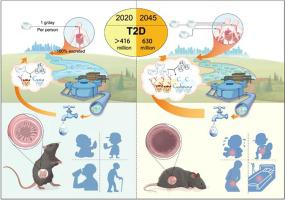Environment International ( IF 10.3 ) Pub Date : 2020-11-03 , DOI: 10.1016/j.envint.2020.106244 Runshuai Zhang , Yuanzhen He , Luxia Yao , Jie Chen , Shihao Zhu , Xinxin Rao , Peiyuan Tang , Jia You , Guoqiang Hua , Lu Zhang , Feng Ju , Lianfeng Wu

|
Metformin (MET), a worldwide used drug for type 2 diabetes, has been found with the largest amount by weight among all drugs in aquatic environment, including the drinking water systems where this emerging micropollutant is inevitably transformed during chlorination process. Whether MET chlorination byproducts Y (C4H6ClN5) and C (C4H6ClN3) exist in drinking water remains unknown. Although MET has health-promoting properties, whether or how its chlorination byproducts affect health is still uncharacterized. Here we reveal that MET and byproduct C are present in worldwide drinking water with the highest doses detected for MET and C as 1203.5 ng/L and 9.7 ng/L respectively. Under simulated chlorination conditions, we also demonstrate that both byproducts can be increasingly produced with increment of MET concentration, suggesting a hidden threat on the safety and sustainability of global water supply. Through systematic evaluations, we demonstrate that MET chlorination byproducts Y and C exhibit toxicities instead of genotoxicity to live worms and human HepG2 cells at millimolar doses. Moreover, both byproducts are harmful to mice and particularly Y at 250 ng/L destroys the mouse small intestine integrity. Unprecedentedly, we unveil boiling and activated carbon adsorption as effective alternative solutions that may be in urgent demand globally for removing these byproducts from drinking water.
中文翻译:

饮用水中的二甲双胍氯化副产物显示出潜在的健康隐患
二甲双胍(MET)是世界范围内用于治疗2型糖尿病的药物,在水生环境中,包括饮用水系统中,这种药物的重量均占所有药物重量的最大比例,在这种饮用水中,这种新兴的微污染物在氯化过程中不可避免地发生了转化。MET氯化副产物Y(C 4 H 6 ClN 5)和C(C 4 H 6 ClN 3)是否存在于饮用水中仍然未知。尽管MET具有促进健康的特性,但尚不清楚其氯化副产物是否或如何影响健康。在这里,我们揭示出全球饮用水中存在MET和副产物C,所检测到的MET和C的最高剂量分别为1203.5 ng / L和9.7 ng / L。在模拟氯化条件下,我们还证明,随着MET浓度的增加,两种副产物都可以越来越多地产生,这暗示着对全球供水安全性和可持续性的潜在威胁。通过系统的评估,我们证明以毫摩尔剂量,MET氯化副产物Y和C对活虫和人类HepG2细胞表现出毒性而不是遗传毒性。此外,两种副产物均对小鼠有害,尤其是250 ng / L的Y会破坏小鼠小肠的完整性。前所未有地,我们将沸腾和活性炭吸附作为有效的替代解决方案推出,可能是全球范围内迫切需要从饮用水中去除这些副产物的解决方案。











































 京公网安备 11010802027423号
京公网安备 11010802027423号